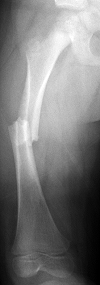Study examines the effects of osteoporosis drugs in children with genetic bone disorders

Previous case reports in patients with osteogenesis imperfecta (OI) have suggested that treatment with bisphosphonates, which are commonly prescribed for osteoporosis, may be associated with atypical femur fractures. A new retrospective study of 119 children with OI indicates that such fractures are related to the severity of OI rather than to bisphosphonate use, however.
OI is a group of genetic disorders that affect the body's ability to make strong bones. People with the condition have bones that break easily, often from mild trauma or with no apparent cause.
"Children with severe OI break their bones less often when they receive intravenous bisphosphonate treatment, but unfortunately fractures still do occur. In this study, we found that bisphosphonate treatment did not change the radiological appearance of femur fractures," said Dr. Frank Rauch, senior author of the Journal of Bone and Mineral Research study.
More information: Pamela Trejo et al. Diaphyseal Femur Fractures in Osteogenesis Imperfecta: Characteristics and Relationship with Bisphosphonate Treatment, Journal of Bone and Mineral Research (2016). DOI: 10.1002/jbmr.3071












